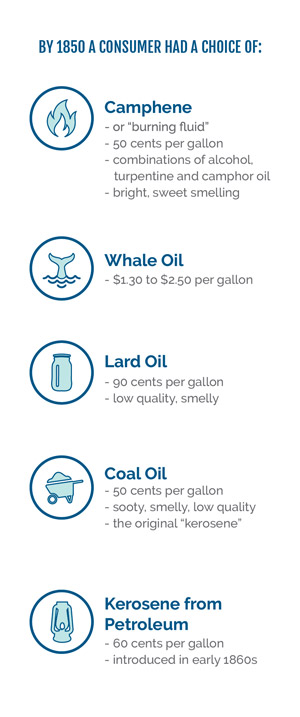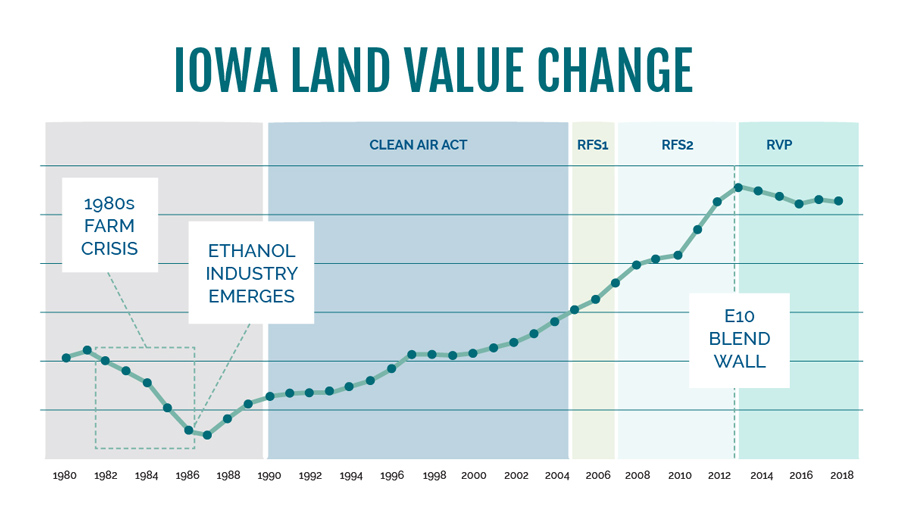In order to envision the future of an industry, one must first understand its past, and biofuels might just have one of the most illustrious — but under-recognized — stories in recent history. With year-round E15 finally past the finish line and a long road ahead for biofuels, it is critical to remember how the industry got this far — from the triumphs to the setbacks and everything in between.
The long history of energy in the U.S. is riddled with myths and misconceptions. For instance, contrary to popular belief, ethanol has been used as fuel in the United States for nearly two centuries. Its usage dates back to the early 1800s, when the most commonly used fuel was camphene, a mixture of alcohol and turpentine. According to the “History of Renewable Fuels,” the internal combustion engine had not yet been invented, but there was a massive market for fuel to power lights, and camphene was used to power lamps and lights throughout the young nation. Then Edwin Drake struck oil in 1859, and while the textbooks claim that it was just in time to prevent the mass slaughtering of whales for lamp oil, kerosene made from oil actually showed up in an already established lighting fuel market. Although kerosene likely could have dominated that market on its own, it was slightly less economical than camphene.
In 1862, however, a $2.08 per gallon sales tax was placed on alcohol in order to help pay for the Civil War. While it was meant to be a tax on drinking alcohol, it led to the destruction of the entire camphene market, despite the alcohol industry’s resistance to the legislation. Many distilleries were closed down, which consequently hurt the thousands of farmers who supplied them the feedstock to produce millions of gallons of alcohol for lighting fuel. This, it just so happened, was rather convenient for America’s burgeoning oil industry.
The demise of the camphene market foreshadowed what would happen to ethanol in the early 1900s, when the 18th Amendment — better known as Prohibition — was put in place. A common misconception is that Prohibition was about Christian values and putting an end to the national epidemic of alcoholism, which, as we all know, it failed to accomplish. It did, however, succeed in stopping fuel ethanol in its tracks.
Charles Mudede writes in an analysis of the documentary “Pump” that Henry Ford and Charles Kettering, the faces of the auto industry at the time, avidly promoted the use of plant-based alcohol for fuel; in fact, the Ford Model T was designed to run on either gasoline or ethanol. But in the meantime, Standard Oil founder John D. Rockefeller was working hard behind the scenes to ensure that market would not grow. He funded millions to the Women’s Christian Temperance Fund, the main driver in pushing Congress to vote in favor of the 18th Amendment. According to Hemmings.com, critics of the theory insist that this is nothing but a conspiracy theory and that Rockefeller really was a large supporter of Prohibition for temperance, but the truth may be lost to history.
Either way, Prohibition took ethanol down with it even though the bill did allow for the sale and experimentation of alcohol for fuel. It was an unfortunate outcome, especially given the economic climate of that time; experts say an emerging alcohol fuel industry could have been conducive in saving farmers and distilleries from bankruptcy in the midst of the Great Depression, even possibly helping to bring it to an end.
Alcohol-gasoline blends were used on a small scale in subsequent years until 1973, when a 10 percent blend of ethanol was allowed into the fuel supply. Although its octane and economic advantages gained recognition, it wasn’t until the late 1980s that a legitimate ethanol industry would emerge once again. This was largely due to the agricultural crisis, when grain crops like corn were oversupplied, land values were depressed, and farm bankruptcies became increasingly common. By 1986 corn prices were so low that ethanol production became the only viable outlet for the surplus, and by 1987 four percent of the U.S. corn crop was being used for just that, creating an upturn for rural America.
While the biofuels industry was quickly gaining traction in the ag sector, it wasn’t long before it was also touted for its environmental benefits. The Clean Air Act, established in 1963, was amended in 1990 amid increasing concerns about tailpipe emissions, acid rain and urban smog. The revisions encouraged the use of fuel made from both grain and natural gas to reduce dependence on foreign fuel and help curb America’s ever-worsening air pollution. According to the Environment Protection Agency (EPA), in 2005, the Energy Policy Act was in the final stages of development to amend the Clean Air Act. Inside that bill was an addendum called the Renewable Fuel Standard, now known as RFS1.
RFS1 called for 4 billion gallons of renewable fuel in the nation’s automotive fuel supply, set to increase to 7.5 billion gallons by 2012. Lawmakers quickly saw the positive impact it had on air pollution, national security, and the Midwest economy and expanded the program through the Energy Independence and Security Act of 2007, now referred to as RFS2. Under RFS2, 36 billion gallons of renewable domestic fuel are to be blended into the fuel supply by 2022, about half of which is to be advanced or cellulosic biofuel.
Each summer the EPA issues a proposal governing how many gallons of biofuel must be blended with the fuel supply in the year ahead. The agency then accepts comments for a period before issuing a final rule under the RFS. These targets, called Renewable Volume Obligations (RVOs), set the annual pace to reach 36 billion gallons by 2022. In 2018, for example, RVOs were set at 19.29 billion gallons, including 15 billion gallons of starch-based and 4.29 billion gallons of advanced biofuel.
Most ethanol opponents are counting on the RFS “phasing out” after 2022; however, that is ignorant on an economic, environmental and political level. According to the RFS, at that point the EPA will select subsequent RVOs based on the success of the current program, which has been undoubtable so far. The RFS has supported more than 360,000 American jobs, greatly lowered our dependence on foreign oil, significantly reduced greenhouse gases and airborne toxins, and, in the words of Henry Ford, caused a “rural renaissance” in America’s heartland.
After RFS2 was passed in 2007, farmers and ethanol producers started pushing for relief from an outdated regulation known as Reid Vapor Pressure (RVP). The original Clean Air Act limited the amount of emissions as measured by a fuel’s RVP, or how quickly it evaporates. It also helps to determine how much air pollution a fuel causes in urban areas. Congress specified that E10 would receive a one pound per square inch (psi) RVP waiver because of its ability to reduce tailpipe emissions.
However, E15 was not yet on the market at the time these regulations were put in effect, so the language used in the waiver meant that it only applied to ethanol blends up to 10 percent. In reality, higher blends lower a fuel’s RVP, but the legislation was outdated and therefore barred the sale of cleaner-burning, more cost-effective E15 in the summer months, when smog and fuel prices tend to peak.
Over the last decade, ethanol producers and industry supporters have put immeasurable funding, time and effort toward securing RVP relief for E15. Unfortunately, ethanol has been at the mercy of political corruption and attacks from Big Oil since long before that, creating a field of bureaucratic landmines in the way of what should have been a simple change to the mandate.
But on May 31, 2019 — just in time for the summer driving season — David landed a hit against Goliath. The EPA fulfilled a commitment made by President Trump and issued a final rule for RVP relief, allowing access to E15 all year round. This was a monumental victory for farmers, ethanol producers and consumers alike.
“The Trump Administration’s year-round E15 rule is a huge win for farmers, clean fuels and consumer choice,” said POET CEO and Founder Jeff Broin. “Millions of drivers will now have the freedom to choose cleaner-burning E15 and enjoy greater savings at the pump when they need it most — during the summer driving season when fuel prices peak. Nationwide adoption of E15 is expected to drive the production of 7 billion gallons of biofuels, creating an additional demand for 2 billion bushels of corn each year.”
Year-round E15 will play a crucial role in unlocking domestic demand for farmers in the midst of an ag crisis, creating Midwest jobs, reducing air pollution, and providing a better, cheaper fuel choice at the pump 365 days a year. Ethanol exports will continue to increase as well, and expansion of corn markets will help diminish the 20-billion-bushel global surplus and drive commodity prices to help bring worldwide agriculture to prosperity once again.
True, the biofuels industry has long suffered at the hands of Big Oil’s political games and undoubtedly will again. But if ethanol’s history has shown us anything, it’s that we’re never down for long.
In a time when the effects of global climate change continue to worsen and fossil fuel supplies are dwindling, biofuels like ethanol are proving to be the only readily available, economical way to reverse the ever-worsening effects of human energy consumption.
Henry Ford called ethanol the “fuel of the future.” That future is now.









